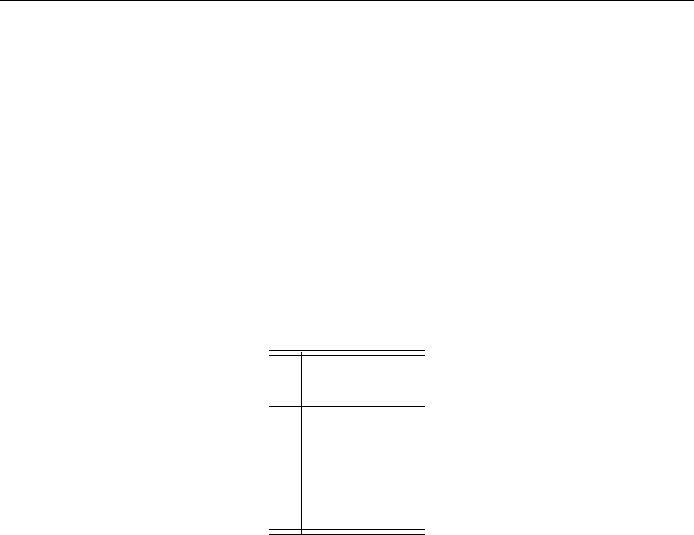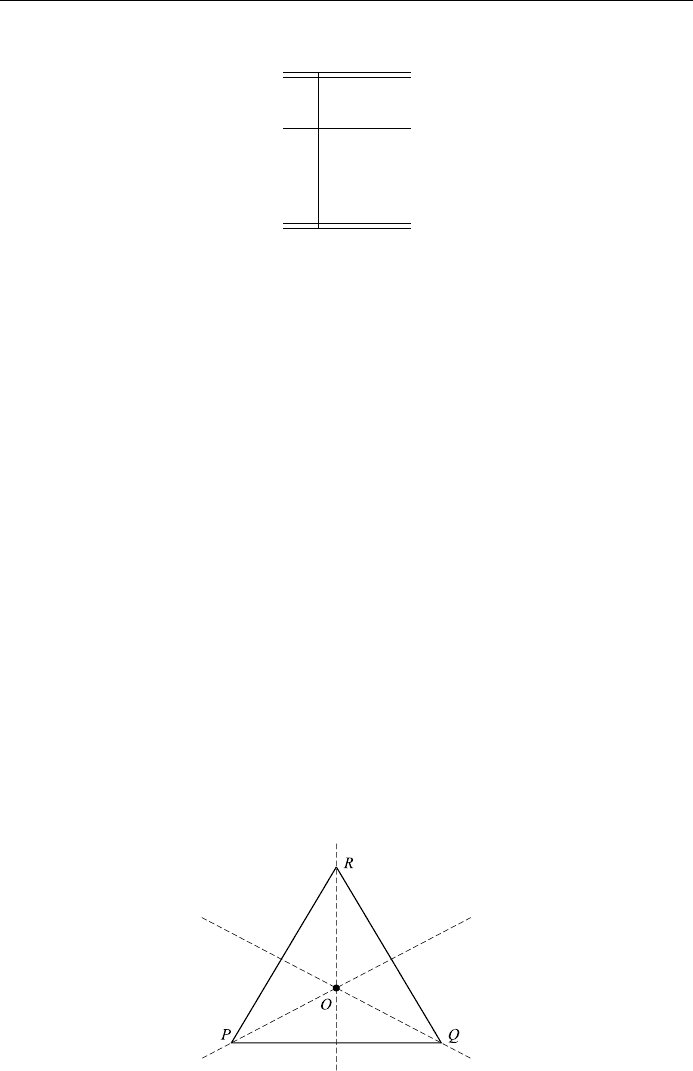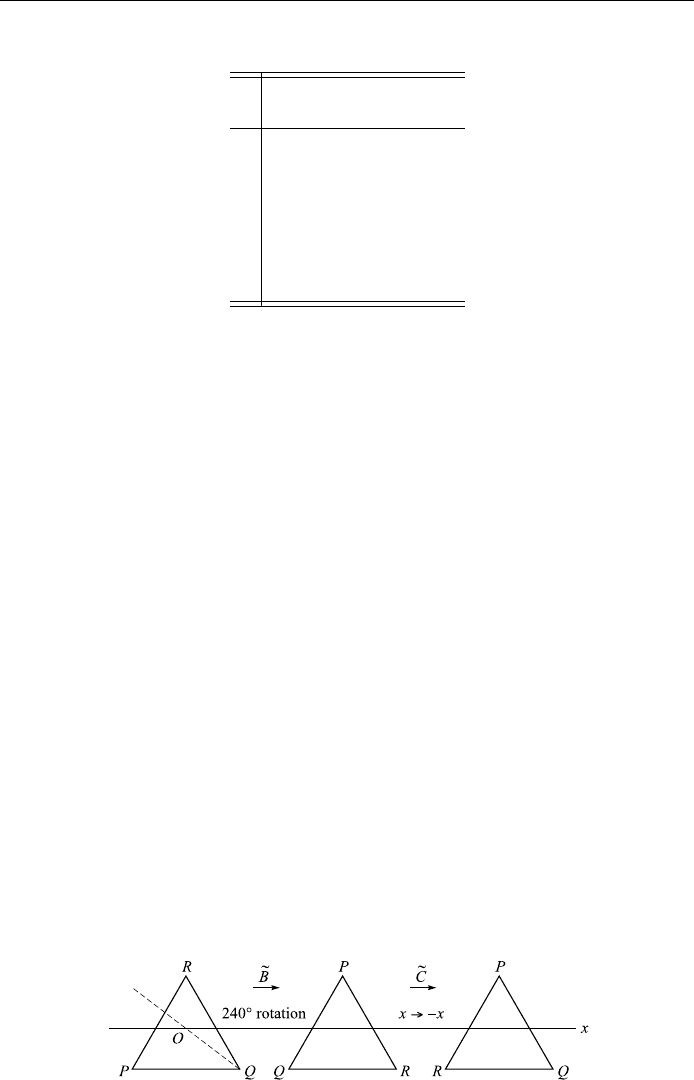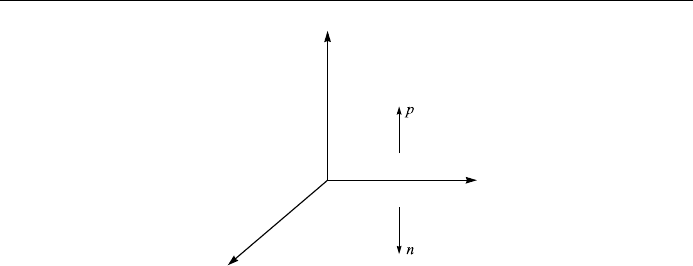Chow T.L. Mathematical Methods for Physicists: A Concise Introduction
Подождите немного. Документ загружается.


Equation (12.7) can be written in matrix form
~
x
0
~
~
x 12:8
with
~
11
12
13
21
22
23
31
32
33
0
B
@
1
C
A
;
~
x
x
1
x
2
x
3
0
B
@
1
C
A
;
~
x
0
x
0
1
x
0
2
x
0
3
0
B
@
1
C
A
:
The matrix
~
is an orthogonal matrix a nd the value of its determinant is 1. The
`ÿ1' value corresponds to an operation involving an odd number of re¯ections.
For Eq. (12.6) the matrix
~
has the form
~
cos sin 0
ÿsin cos 0
001
0
B
@
1
C
A
: 12:6a
For a rotation, an inversion about an axis, or a re¯ection in a plane through the
origin, the distance of a point from the origin remains unchanged:
r
2
x
2
1
x
2
2
x
2
3
x
0
1
2
x
0
2
2
x
0
3
2
: 12:9
The symmetry group D
2
; D
3
Let us now examine two simple examples of symmetry and groups. The ®rst one is
on twofold symmetry axes. Our system consists of six particles: two identical
particles A located at a on the x-axis, two particles, B at b on the y-axis,
and two particles C at c on the z-axis. These particles co uld be the atoms of a
molecule or part of a crystal. Each axis is a twofold symmetry axis. Clearly, the
identity or unit operator (no rotation) will leave the system unchanged. What
rotations can be carried out that will leave our system invariant? A certain com-
bination of rotations of radians about the three coordinate axes will do it. The
orthogonal matrices that represent rotations about the three coordinate axes can
be set up in a similar manner as was done for Eq. (12.6a), and they are
~
100
0 ÿ10
00ÿ1
0
B
@
1
C
A
;
~
þ
ÿ10 0
01 0
00ÿ1
0
B
@
1
C
A
;
~
ÿ
ÿ100
0 ÿ10
001
0
B
@
1
C
A
;
where
~
is the rotational matrix about the x-axis, and
~
þ and
~
ÿ are the rotational
matrices about y-andz-axes, respectively. Of course, the identity operator is a
unit matrix
446
ELEMENTS OF GROUP THEORY

~
E
100
010
001
0
B
@
1
C
A
:
These four elements form an Abelian group with the group multiplication table
shown in Table 12.5. It is easy to check this group table by matrix multiplication.
Or you can check it by analyzing the ope rations themselves, a tedious task. This
demonstrates the power of mathematics: when the system becomes too complex
for a direct physical interpretation, the usefulness of mathematics shows.
This symmetry group is usually labeled D
2
, a dihedral group with a twofold
symmetry axis. A dihedral group D
n
with an n-fold symmetry axis has n axes with
an angular separation of 2 =n radians and is very useful in crystallographic study.
We next consider an example of threefold symmetry axes. To this end, let us re-
visit Example 12.8. Rotations of the triangle of 08, 1208, 2408, and 3608 leave the
triangle invariant. Rotation of the triangle of 08 means no rotation, the triangle is
left unchanged; this is represented by a unit matrix (the identity element). The
other two orthogonal rotational matrices can be set up easily:
~
A R
z
1208
ÿ1=2 ÿ
3
p
=2
3
p
=2 ÿ1=2
0
@
1
A
;
~
B R
z
2408
ÿ1=2
3
p
=2
ÿ
3
p
=2 ÿ1=2
0
@
1
A
;
and
~
E R
z
0
10
01
:
We notice that
~
C R
z
3608
~
E. The set of the three elements
~
E;
~
A;
~
B forms a
cyclic group C
3
with the group multiplication table shown in Table 12.6. The z-
447
SOME SPECIAL GROUPS
Table 12.5.
~
E
~
~
þ
~
ÿ
~
E
~
E
~
~
þ
~
ÿ
~
~
~
E
~
ÿ
~
þ
~
þ
~
þ
~
ÿ
~
E
~
~
ÿ
~
ÿ
~
þ
~
~
E

axis is a threefold symmetry axis. There are three additional axes of symmetry in
the xy plane: each corner and the geometric center O de®ning an axis; each of
these is a twofold symmetry axis (Fig. 12.4). Now let us consider re¯ection opera-
tions. The following successive operations will bring the equilateral angle onto
itself (that is, be invariant):
~
E the identity; triangle is left unchanged;
~
A triangle is rotated through 1208 clockwise;
~
B triangle is rotated through 2408 clockwise;
~
C triangle is re¯ected about axis OR (or the y-axis);
~
D triangle is re¯ected about axis OQ;
~
F triangle is re¯ected about axis OP.
Now the re¯ection about axis OR is just a rotation of 1808 about axis OR, thus
~
C R
OR
1808
ÿ10
01
:
Next, we notice that re¯ection about axis OQ is equivalent to a rotation of 24 08
about the z-axis foll owed by a re¯ection of the x-axis (Fig. 12.5):
~
D R
OQ
1808
~
C
~
B
ÿ10
01
ÿ1=2
3
p
=2
ÿ
3
p
=2 ÿ1=2
þ!
1=2 ÿ
3
p
=2
ÿ
3
p
=2 ÿ1=2
þ!
:
448
ELEMENTS OF GROUP THEORY
Table 12.6.
~
E
~
A
~
B
~
E
~
E
~
A
~
B
~
A
~
A
~
B
~
E
B
~
B
~
E
~
A
Figure 12.4.

Similarly, re¯ection about axis OP is equivalent to a rotation of 1808 followed by
a re¯ection of the x-axis:
~
F R
OP
1808
~
C
~
A
1=2
3
p
=2
3
p
=2 ÿ1=2
þ!
:
The group multiplication table is shown in Table 12.7. We have constructed a six-
element non-Abelian group and a 2 2 irreducible matrix representation of it.
Our group is known as D
3
in crystallography, the dihedral group with a threefold
axis of symmetry.
One-dimensional unitrary group U1
We now consider groups with an in®nite number of elements. The group element
will contain one or more parameters that vary continuously over some range so
they are also know n as continuous groups. In Example 12.7, we saw that the
complex numbers (1; i; ÿ1; ÿi form a cyclic group of order 3. These group ele-
ments may be interpreted as successive 908 rotations in the complex plane
0;=2;; 3=2, and so they may be written as e
i'
with ' 0, =2, ,3=2. If
' is allowed to vary continuously over the range 0; 2, then we will have, instead
of a four-member cyclic group, a continuous group with multiplication for the
composition rule. It is straightforward to check that the four group axioms are all
449
SOME SPECIAL GROUPS
Table 12.7.
~
E
~
A
~
B
~
C
~
D
~
F
~
E
~
E
~
A
~
B
~
C
~
D
~
F
~
A
~
A
~
B
~
E
~
D
~
F
~
C
~
B
~
B
~
E
~
A
~
F
~
C
~
D
~
C
~
C
~
F
~
D
~
E
~
B
~
A
~
D
~
D
~
C
~
F
~
A
~
E
~
B
~
F
~
F
~
D
~
C
~
B
~
A
~
E
Figure 12.5.

met. In quantum mechanics, e
i'
is a complex phase factor of a wave function,
which we denote by U'). Obviously, U0 is an identity element. Next,
U'U'
0
e
i''
0
U' '
0
;
and U' '
0
is an element of the group. There is an inverse: U
ÿ1
'Uÿ',
since
U'Uÿ'Uÿ'U'U0E
for any '. The associative law is satis®ed:
U'
1
U'
2
U'
3
e
i'
1
'
2
e
i'
3
e
i'
1
'
2
'
3
e
i'
1
e
i'
2
'
3
U'
1
U'
2
U'
3
:
This group is a one-dimensional unitary group; it is called U1. Each element is
characterized by a continuous parameter ',0 ' 2; ' can take on an in®nite
number of values. Moreover, the elements are diÿerentiable:
dU U' d'ÿU'e
i'd'
ÿ e
i'
e
i'
1 id'ÿe
i'
ie
i'
d' iUd'
or
dU=d' iU:
In®nite groups whose elements are diÿerentiable functions of their parameters
are called Lie groups. The diÿerentiability of group elements allows us to develop
the concept of the generator. Furthermore, instead of studying the whole group,
we can study the group elements in the neighborhood of the identity element.
Thus Lie groups are of particular interest. Let us take a brief look at a few more
Lie groups.
Orthogonal groups SO2 and SO3
The rotations in an n-dimensional Euclidean space form a group, called O n. The
group elements can be represented by n n orthogonal matrices, each with
nn ÿ 1=2 independent elements (Problem 12.12). If the determinant of O is set
to be 1 (rotation only, no re¯ection), then the group is often labeled SOn. The
label O
n
is also often used.
The elements of SO2 are familiar; they are the rotations in a plane, say the xy
plane:
x
0
y
0
þ!
~
R
x
y
þ!
cos sin
ÿsin cos
x
y
:
450
ELEMENTS OF GROUP THEORY

This group has one parameter: the angle . As we stated earlier, groups enter
physics because we can carry out transformations on physical systems and the
physical systems often are invariant under the transformations. Here x
2
y
2
is
left invariant.
We now introduce the concept of a generator and show that rotations of SO2
are generated by a special 2 2 matrix ~
2
, where
~
2
0 ÿi
i 0
:
Using the Euler identity, e
i
cos i sin , we can express the 2 2 rotation
matrices R in exponential form:
~
R
cos sin
ÿsin cos
~
I
2
cos i~
2
sin e
i~
2
;
where
~
I
2
is a 2 2 unit matrix. From the exponential form we see that multi-
plication is equivalent to addition of the arguments. The rotations close to the
identity element have small angles 0: We call ~
2
the generator of rotations for
SO2.
It has been shown that any element g of a Lie group can be written in the form
g
1
;
2
; ...;
n
exp
X
i1
i
i
F
i
þ!
:
For n parameters there are n of the quantities F
i
, and they are called the
generators of the Lie group.
Note that we can get ~
2
from the rotation matrix
~
R by diÿerentiation at the
identity of SO2, that is, 0: This suggests that we may ®nd the generators of
other groups in a similar manner.
For n 3 there are three independent parameters, and the set of 3 3 ortho-
gonal matrices with determinant 1 also forms a group , the SO3, its general
member may be expressed in terms of the Euler angle rotation
R; þ; ÿR
z
0
0; 0;R
y
0;þ;0R
z
0; 0;ÿ;
where R
z
is a rotation about the z-axis by an angle ÿ, R
y
a rotation about the y-
axis by an angle þ, and R
z
0
a rotation about the z
0
-axis (the new z-axis) by an
angle . This sequence can perform a general rotation. The separate rotations can
be written as
~
R
y
þ
cos þ 0 ÿsin þ
01 0
sin þ 0 cos þ
0
B
@
1
C
A
;
~
R
z
ÿ
cos ÿ sin ÿ 0
ÿsin ÿ cos ÿ 0
0 o 1
0
B
@
1
C
A
;
451
SOME SPECIAL GROUPS

~
R
x
10 0
0cos sin
0 ÿsin cos
0
B
@
1
C
A
:
The SO3 rotations leave x
2
y
2
z
2
invariant.
The rotations R
z
ÿ form a group, called the group R
z
, which is an Abelian sub-
group of SO3. To ®nd the generator of this group, let us take the following
diÿerentiation
ÿid
~
R
z
ÿ=dÿ
ÿ0
ÿ
ÿ
0 ÿi 0
i 00
000
0
B
@
1
C
A
~
S
z
;
where the insertion of i is to make
~
S
z
Hermitian. The rotation R
z
ÿ through an
in®nitesimal angle ÿ can be written in terms of
~
S
z
:
R
z
ÿ
~
I
3
dR
z
ÿ
dÿ
ÿ
ÿ
ÿ
ÿ
ÿ0
ÿ Oÿ
2
~
I
3
iÿ
~
S
z
:
A ®nite rotation Rÿ may be constructed from successive in®nitesimal rotations
R
z
ÿ
1
ÿ
2
~
I
3
iÿ
1
~
S
z
~
I
3
iÿ
2
~
S
z
:
Now let ÿ ÿ=N for N rotations, with N !1, then
R
z
ÿ lim
N!1
~
I
3
iÿ=N
~
S
z
N
expi
~
S
z
;
which identi®es
~
S
z
as the generator of the rotation group R
z
. Similarly, we can
®nd the generators of the subgroups of rotations about the x-axis and the y-axis.
The SUn groups
The n n unitary matrices
~
U also form a group, the Un group. If there is the
additional restriction that the determinant of the matrices be 1, we have the
special unitary or unitary unimodular group, SUn. Each n n unitary matrix
has n
2
ÿ 1 independent parameters (Problem 12.14).
For n 2wehaveSU2 and possible ways to parameterize the matrix U are
~
U
ab
ÿb* a*
;
where a, b are arbitrary complex numbers and jaj
2
jbj
2
1. These parameters
are often called the Cayley±Klein parameters, and were ®rst introduced by Cayley
and Klein in connection with problems of rotation in classical mechanics.
Now let us write our unitary matrix in exponential form:
~
U e
i
~
H
;
452
ELEMENTS OF GROUP THEORY

where
~
H is a Hermitian matrix. It is easy to show that e
i
~
H
is unitary:
e
i
~
H
e
i
~
H
e
ÿi
~
H
e
i
~
H
e
i
~
Hÿ
~
H
1:
This implies that any n n unitary matrix can be written in exponential form with
a particularly selected set of n
2
Hermitian n n matrices,
~
H
j
~
U exp i
X
n
2
j1
j
~
H
j
þ!
;
where the
j
are real parameters. The n
2
~
H
j
are the generators of the group Un.
To specialize to SUn we need to meet the restriction det
~
U 1. To impose this
restriction we need to use the identity
det e
~
A
e
Tr~A
for any square matrix
~
A. The proof is left as homework (Problem 12.15). Thus the
condition det
~
U 1 requires Tr
~
H 0 for every
~
H. Accordingly, the generators
of SUn are any set of n n traceless Hermitian matrices.
For n 2, SUn reduces to SU2, which describes rotations in two-dimen-
sional complex space. The determinant is 1. There are three continuous para-
meters (2
2
ÿ 1 3). We have expressed these as Cayley±Klein parameters. The
orthogonal group SO3, determinant 1, describes rotations in ordinary three-
dimensional space and leaves x
2
y
2
z
2
invariant. There are also three inde-
pendent parameters. The rotation interpretations and the equality of numbers of
independent parameters suggest these two groups may be isomorphic or homo-
morphic. The corres pondence between these groups has been proved to be two-to-
one. Thus SU2 and SO3 are isomorphic. It is beyond the scope of this book to
reproduce the proof here.
The SU2 group has found various applic ations in particle physics. For exam-
ple, we can think of the proton (p) and neutron (n) as two states of the same
particle, a nucleon N, and use the electric charge as a label. It is also useful to
imagine a particle space, called the strong isospin space, where the nucleon state
points in some direction, as shown in Fig. 12.6. If (or assuming that) the theory
that describes nucleon interactions is invariant under rotations in strong isospin
space, then we may try to put the proton and the neutron as states of a spin-like
doublet, or SU2 doublet. Other hadrons (strong-interacting particles) can also
be classi®ed as states in SU2 multiplets. Physicists do not have a deep under-
standing of why the Standard Model (of Elementary Particles) has an SU2
internal symmetry.
For n 3 there are eight independent parameters 3
2
ÿ 1 8), and we have
SU3, which is very useful in describing the color symmetry.
453
SOME SPECIAL GROUPS

Homogeneous Lorentz group
Before we describe the homogeneous Lorentz group, we need to know the
Lorentz transformation. This will bring us back to the origin of special theory
of relativity. In classical mechanics, time is absolute and the Galilean trans-
formation (the principle of Newtonian relativity) asserts that all inertial frames
are equival ent for describing the laws of classical mechanics. But physicists in
the nineteenth century found that electromagnetic theory did not seem to obey
the principle of Newtonian relativity. Classical electromagnetic theory is sum-
marized in Maxwell's equations, and one of the consequences of Maxwell's
equations is that the speed of light (electromagnetic waves) is independent of
the motion of the source. However, under the Galilean transformation, in a
frame of reference moving uniformly with respect to the light source the light
wave is no longer spherical and the speed of light is also diÿerent. Hence, for
electromagnetic phenomena, inertial frames are not equivalent and Maxwell's
equations are not invariant under Galilean transformation. A number of
experiments were proposed to resolve this con¯ict. After the Michelson±
Morley experiment failed to detect ether, physicists ®nally accepted that
Maxwell's equations are correct and have the same form in all inertial frames.
There had to be some trans formation other than the Galilean transformation
that would make both electromagnetic theory and classical mechanical invar-
iant.
This desired new transformation is the Lorentz transformation, worked out by
H. Lorentz. But it was not until 1905 that Einstein realized its full implications
and took the epoch-making step involved. In his paper, `On the Electrodynamics
of Moving Bodies' (The Principle of Relativity , Dover, New York, 1952), he
developed the Special Theory of Rela tivity from two fundamental postulates,
which are rephrased as follows:
454
ELEMENTS OF GROUP THEORY
Figure 12.6. The strong isospin space.

(1) The laws of physics are the same in all inertial frame. No preferred inertial
frame exists.
(2) The speed of light in free space is the same in all inertial frames and is inde-
pendent of the motion of the source (the emitting body).
These postulates are often called Einstein's principle of relativity, and they radi-
cally revised our concepts of space and time. Newton's laws of motion abolish the
concept of absolute space, because according to the laws of motion there is no
absolute standard of rest. The non-existence of absolute rest means that we can-
not give an event an absolute position in space. This in turn means that space is
not absolute. This disturbed Newton, who insisted that there must be some abso-
lute standard of rest for motion, remote stars or the ether system. Absolute space
was ®nally abolished in its M axwellian role as the ether. Then absolute time was
abolished by Einstein's special relativity. We can see this by sending a pulse of
light from one place to another. Since the speed of light is just the distance it has
traveled divided by the time it has taken, in Newtonian theory, diÿerent observers
would measure diÿerent speeds for the light because time is absolute. Now in
relativity, all observers agree on the speed of light, but they do not agree on the
distance the light has traveled. So they cannot agree on the time it has taken. That
is, time is no longer absolute.
We now come to the Lorentz transformation, and suggest that the reader to
consult books on special relativity for its derivation. For tw o inertial frames with
their corresponding axes parallel and the relative velocity v along the x
1
x axis,
the Lorentz transformation has the form:
x
0
1
ÿx
1
iþx
4
;
x
0
2
x
2
;
x
0
3
x
3
;
x
0
4
ÿx
4
ÿ iþx
1
;
where x
4
ict;þ v= c ,andÿ 1=
1 ÿ þ
2
p
. We will drop the two directions
perpendicular to the motion in the following discussion.
For an in®nitesimal relative velocity v, the Lorentz transformation reduces to
x
0
1
x
1
iþx
4
;
x
0
4
x
4
ÿ iþx
1
;
where þ v=c;ÿ 1=
1 ÿþ
2
q
1: In matrix form we have
x
0
1
x
0
4
þ!
1 iþ
ÿiþ 1
þ!
x
1
x
4
þ!
:
455
SOME SPECIAL GROUPS
